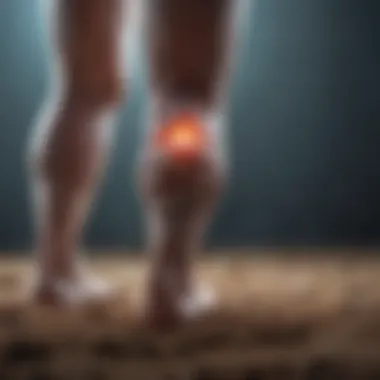Exploring Current Treatment Options for Osteoarthritis


Intro
Osteoarthritis represents a significant challenge in the field of medicine. As a common degenerative joint disease, it affects millions globally. Understanding how it progresses and manifests is critical for effective management. This article presents a detailed overview of treatment options currently available for osteoarthritis. We will explore pharmacological methods, ongoing research, and surgical interventions—all aimed at improving the quality of life for those affected.
Key Findings
Major Results
Research findings indicate that the treatment spectrum for osteoarthritis is broad, encompassing a variety of approaches. Some of the most effective treatments include medications, physical therapy, dietary modifications, and surgical procedures.
- Medications: Nonsteroidal anti-inflammatory drugs (NSAIDs) like ibuprofen or naproxen are among the most commonly used. These drugs help relieve pain and reduce inflammation. Additionally, acetaminophen is recommended for pain relief.
- Physical therapy: Therapeutic exercises can help maintain joint function and strength. Education about proper body mechanics is equally important to avoid further joint stress.
- Weight management: For overweight individuals, losing weight can significantly reduce pressure on weight-bearing joints, leading to pain relief.
It is important to consider patient-specific factors when selecting treatment options.
- Surgical procedures: In cases where conservative treatments are insufficient, surgical options such as arthroscopy and joint replacement can provide relief. These interventions are more invasive but may offer substantial improvement in function for some patients.
Discussion of Findings
The findings underline that no one-size-fits-all solution exists for osteoarthritis treatment. The diversity in treatment options reflects the complexity of the disease and varying patient needs. Comprehensive evaluation and a multidisciplinary approach are recommended for optimal outcomes.
Methodology
Research Design
The exploration of treatment options for osteoarthritis was approached through a systematic review of existing literature. This included peer-reviewed studies, clinical trials, and meta-analyses to ascertain the efficacy of various treatments.
Data Collection Methods
Data was gathered from reputable sources, including PubMed, Cochrane Library, and specialty journals focused on rheumatology and orthopedics. Structured interviews with healthcare professionals provided additional insights into clinical practices.
By analyzing treatment outcomes and patient feedback, this article aims to clarify effective strategies in managing osteoarthritis. The insights gained contribute to the ongoing dialogue among healthcare providers, patients, and researchers.
Prelims to Osteoarthritis
Osteoarthritis represents a significant health concern, impacting a large segment of the population. It is crucial to understand the condition comprehensively as it encompasses more than just physical discomfort. This introduction sets the stage for exploring effective treatment options and the broader implications for both individual patients and healthcare systems.
Definition and Pathophysiology
Osteoarthritis is primarily defined as a degenerative joint disease characterized by the breakdown of cartilage, which cushions the joints, along with changes in the underlying bone and surrounding soft tissues. With time, the loss of cartilage leads to pain, swelling, and stiffness in the affected joints. The biological processes include inflammation and repair mechanisms that fail to maintain the balance. Therefore, defining osteoarthritis goes beyond mere symptoms; it involves understanding the dynamic processes of joint deterioration.
The pathophysiology of osteoarthritis involves a complex interplay of biomechanical factors, cellular responses, and genetic influences. Chondrocytes, the cells within cartilage, play a central role. They respond to mechanical strain and injury by producing inflammatory mediators and proteolytic enzymes, contributing to the degradation of cartilage and the perpetuation of joint damage.
Epidemiology and Risk Factors
Epidemiological studies reveal that osteoarthritis affects millions, making it one of the most common forms of arthritis. Its prevalence rises with age, often affecting individuals aged over 50 and contributing to disabilities. Gender also plays a role; women are at a higher risk post-menopause, likely due to hormonal changes that influence joint health.
The risk factors for osteoarthritis include:
- Obesity: Extra weight increases stress on weight-bearing joints, accelerating degeneration.
- Previous Joint Injuries: Trauma or repetitive stress injuries can predispose individuals.
- Genetics: Family history can indicate a hereditary component.
- Age: Older adults are more susceptible due to cumulative wear and tear.
- Joint Abnormalities: Structural differences may increase disease risk.
"Understanding the risk factors can guide preventive strategies and early interventions for osteoarthritis."
Awareness of these factors is vital for healthcare professionals and patients alike, as they can influence treatment options and outcomes.
Pharmacological Treatments
Pharmacological treatments represent a cornerstone in managing osteoarthritis, offering various options to alleviate pain and improve function. These approaches range from basic analgesics to more complex disease-modifying therapies. Understanding these treatments is crucial for both healthcare providers and patients, as they help navigate the complexities of this degenerative joint disease.
Non-Opioid Analgesics
Non-opioid analgesics are often the first line of treatment for osteoarthritis pain management. Medications such as acetaminophen can be effective in reducing mild to moderate pain. Their appeal lies in the relatively low risk of side effects compared to more potent opioids. Patients should be cautious, however, as exceeding the recommended daily dosage can lead to severe liver damage. Appropriate education on dosage is necessary for anyone considering this kind of medication.
Opioid Analgesics


Opioid analgesics target more severe pain associated with osteoarthritis. Medications like hydrocodone and oxycodone can provide significant relief for patients who do not respond well to non-opioid medications. However, the downside includes a higher risk of dependency and potential side effects such as constipation and drowsiness. It is vital for physicians to closely monitor patients using opioid therapy and to consider non-pharmacological alternatives when possible.
Nonsteroidal Anti-Inflammatory Drugs (NSAIDs)
NSAIDs, such as ibuprofen and naproxen, are commonly used in osteoarthritis for their anti-inflammatory properties. They are effective in reducing swelling and alleviating pain. While beneficial, these medications can cause gastrointestinal issues and cardiovascular risks, especially with prolonged use. Hence, the decision to use NSAIDs should involve a careful assessment of benefits versus potential harm.
Topical Treatments
Topical treatments include creams and gels containing NSAIDs or capsaicin. They provide localized relief with reduced system-wide side effects. Products like diclofenac gel have gained attention for their ease of use and efficacy in managing pain. Application instructions should be clear to ensure that patients do not use excessive amounts, which could irritate the skin or cause other adverse effects.
Corticosteroid Injections
Corticosteroid injections target inflammation directly at the affected joint, providing significant pain relief. Medications like cortisone can be administered on a periodic basis, typically every few months, to manage acute flare-ups. However, while effective, repeated injections can lead to joint damage if overused. Therefore, this strategy should be part of a broader management plan that includes other therapeutic modalities.
Disease-Modifying Osteoarthritis Drugs (DMOADs)
DMOADs are a relatively recent development in the management of osteoarthritis. These drugs aim to slow disease progression, rather than merely alleviating pain. Currently, research is underway to identify effective agents like glucosamine and chondroitin sulfate, which are believed to enhance cartilage health. However, their effectiveness is still debated, and ongoing studies will determine their role in standard therapy.
"The aim of pharmacological treatment is not just pain relief but also improving the overall quality of life for patients with osteoarthritis."
Non-Pharmacological Treatments
Non-pharmacological treatments play a significant role in managing osteoarthritis. They address the condition from a holistic perspective and often complement pharmacological approaches. Utilizing these methods can lead to considerable improvements in pain management, functionality, and overall quality of life for patients. Importantly, these options are generally safer and can be tailored to individual needs, making them an essential part of modern osteoarthritis care.
Physical Therapy
Physical therapy involves targeted exercises and treatments designed to improve joint function and alleviate stiffness. A physical therapist evaluates the patient's specific condition and establishes a personalized program. Techniques used may include stretching exercises, strengthening routines, and modalities like ultrasound or electrical stimulation.
Benefits of physical therapy include:
- Improved mobility and decreased pain
- Increased strength surrounding the affected joints
- Education on proper body mechanics to minimize stress on joints
Patients often find that regular sessions help manage symptoms effectively and can reduce their dependence on medications.
Occupational Therapy
Occupational therapy assists patients in adapting their daily activities to preserve joint function and avoid pain. Therapists will focus on practical strategies for incorporating movements that reduce strain on affected joints. This may involve using specialized tools to ease tasks such as cooking or dressing.
Key elements of occupational therapy include:
- Assessment of daily activities and identifying modifications
- Training on the use of assistive devices
- Recommendations for setting ergonomic workspaces
Such adjustments may lead to greater independence and improved quality of life, as patients learn to perform daily tasks with less discomfort.
Weight Management and Nutrition
Maintaining a healthy weight is critical in managing osteoarthritis since excess weight places additional stress on weight-bearing joints. Weight management encompasses dietary choices and strategies to achieve and maintain a healthy body weight.
Considerations include:
- Emphasizing a balanced diet rich in omega-3 fatty acids, antioxidants, and vitamins
- Monitoring portion sizes and caloric intake
- Consulting with nutritionists for tailored meal plans
Weight loss can lead to significant reductions in pain and improve joint function, making this aspect of treatment vital for many patients.
Exercise and Activity Modification
Regular exercise is paramount for sustaining joint health and mobility. Through low-impact activities, patients can enhance their muscle strength and flexibility, reducing stiffness and pain. Activities like swimming, cycling, and walking are generally well-tolerated.
Patients should also consider modifying activities that exacerbate their symptoms, ensuring a balance between rest and movement. The implementation of an appropriate exercise regimen can significantly enrich one's physical well-being.
Acupuncture and Alternative Therapies
Acupuncture is one alternative therapy being explored for osteoarthritis management. It involves the insertion of fine needles into specific body points to alleviate pain and inflammation.


While research on acupuncture varies, many patients report positive outcomes. Additionally, alternative therapies may include:
- Herbal remedies that focus on anti-inflammatory properties
- Mindfulness and meditation practices to manage pain perception
- Massage therapy to improve circulation and reduce tension
These therapies may not replace conventional treatments but can serve as complementary solutions to enhance overall care.
Incorporating non-pharmacological treatments can empower patients and create a more balanced approach in managing osteoarthritis.
Surgical Options
Surgical interventions for osteoarthritis are vital for patients with advanced joint degeneration who have not responded adequately to other treatment modalities. These options serve as a bridge between conservative treatments and more involved medical management. Surgery can provide tangible improvements in joint function, pain relief, and overall quality of life for patients. However, careful consideration must be given to the choice of surgical procedure based on individual patient factors and the severity of the condition.
Arthroscopy
Arthroscopy is a minimally invasive surgical procedure involving the insertion of a small camera and instruments through small incisions near the affected joint. This method allows surgeons to visualize the interior of the joint, facilitating both diagnosis and treatment. One advantage of arthroscopy is its ability to address loose cartilage and remove damaged tissue. Many patients report a quicker recovery time compared to open surgeries, often returning to normal activities within weeks. However, not all patients are suitable candidates for this procedure. The decision for arthroscopy hinges on specific joint conditions and symptoms.
Osteotomy
Osteotomy involves the realignment of bones in a joint, particularly the knee. This procedure is particularly indicated for patients whose osteoarthritis is localized to one part of the joint. By redistributing weight away from the damaged area, osteotomy can significantly reduce pain and delay the need for joint replacement. Post-surgery, patients can expect a rehabilitation phase that may include physical therapy to ensure proper healing and optimal function. While osteotomy carries risks, it may extend the operational life of natural joints, and good outcomes can lead to improved mobility and a better quality of life.
Joint Replacement Surgery
Joint replacement surgery, typically involving the hip or knee, is often considered when conservative treatments fail. During this procedure, the damaged joint is removed and replaced with a prosthetic implant. Joint replacement has shown to be highly effective in relieving pain and restoring function. Patients often experience dramatic improvements, with many able to engage in physical activities that were previously too painful. Rehabilitation is crucial following surgery; it emphasizes restoring range of motion and strength. Although joint replacement is a significant operation with risks such as infection or blood clots, the benefits often outweigh the potential downsides for suitable candidates.
"Surgical options may present as the last line of treatment for patients suffering severe osteoarthritis, leading to significant improvements in their lives."
In summary, surgical options are a critical component of osteoarthritis treatment. Each surgical method—arthroscopy, osteotomy, and joint replacement—carries distinct benefits and considerations. The choice of surgery ultimately depends on individual patient needs, severity of osteoarthritis, and how well other treatment options have been utilized.
Emerging Therapies
Emerging therapies represent a significant frontier in the treatment of osteoarthritis. This section emphasizes the potential of innovative treatment modalities that may provide benefits beyond traditional approaches. With the increasing prevalence of this degenerative joint disease, the exploration of new therapies is essential to enhance patient outcomes and quality of life. Emerging therapies often focus on repairing the underlying damage to joint tissues rather than merely alleviating symptoms. This shift in treatment philosophy holds promise for more sustainable management of osteoarthritis.
Platelet-Rich Plasma (PRP) Therapy
Platelet-rich plasma therapy is gaining traction as a promising approach in treating osteoarthritis. This therapy involves extracting a sample of the patient’s blood, processing it to concentrate the platelets, and then reinjecting it into the affected joint. The concentrated platelets contain growth factors that may promote healing and reduce inflammation.
Benefits of PRP therapy include:
- Minimally invasive: PRP therapy is typically done on an outpatient basis.
- Reduced downtime: Most patients can resume normal activities shortly after treatment.
- Potential for tissue regeneration: Growth factors in PRP may aid in tissue healing.
However, PRP therapy is not devoid of considerations. The variability in the preparation and application of PRP can lead to inconsistent results among patients. More controlled studies are needed to establish its long-term efficacy and optimized protocols.
Stem Cell Therapy
Stem cell therapy involves harvesting stem cells from the patient’s bone marrow or adipose tissue. These cells have the unique ability to differentiate into various cell types, potentially regenerating damaged cartilage in osteoarthritis. The treatment aims to harness the body’s intrinsic healing mechanisms.
The potential advantages of stem cell therapy are:
- Cartilage regeneration: Stem cells may facilitate the repair of damaged tissues.
- Long-lasting relief: Some patients report extended periods of relief from osteoarthritis symptoms.
- Personalized treatment: Stem cells are obtained from the patient, reducing the chances of rejection.
Like other emerging therapies, stem cell therapy carries risks and uncertainties. Concerns regarding the ethical implications, regulatory status, and long-term effects must be addressed. Currently, the effectiveness of this therapy is an area of intense research, and further studies are needed to draw definitive conclusions on its suitability for widespread clinical use.
Gene Therapy
Gene therapy offers a novel approach to treat osteoarthritis at a molecular level. This technique involves delivering genetic material into a patient’s cells to counteract disease processes or promote healing. Gene therapy aims to introduce genes that encode for anti-inflammatory proteins or growth factors to mitigate the effects of osteoarthritis.
Key points about gene therapy include:
- Targeted treatment: Gene therapy can be designed to target specific pathways involved in joint degeneration.
- Long-term impact: This approach may lead to sustained improvements in joint function.
- Research potential: Ongoing studies are exploring various strategies, from viral vectors to CRISPR technologies.
Nonetheless, gene therapy raises critical ethical and safety considerations. Questions about the long-lasting effects of genetic modifications and the potential for unexpected consequences must be navigated carefully.
As the understanding of osteoarthritis evolves, so does the landscape of its treatment. Emerging therapies—such as PRP, stem cells, and gene therapy—highlight the potential for innovative strategies that may redefine patient care in the future.


Psychological Considerations
The psychological aspects of osteoarthritis often go unnoticed compared to the physical elements of the disease. However, understanding these considerations is essential. Chronic pain can lead to mental health issues such as anxiety, depression, and diminished quality of life. Managing the mental aspect of osteoarthritis is as important as addressing the physical symptoms. Patients must be aware that the impact of their condition can extend beyond the joints, affecting emotional well-being.
Chronic pain does not just inflict physical suffering; it can also influence a person's thoughts, feelings, and overall mental state. Many studies indicate that chronic pain often leads to increased stress levels, resulting in changes in mood and behavior. The emotional burden of osteoarthritis may lead to feelings of helplessness and frustration, which complicates pain management and rehabilitation efforts. More attention to this area can lead to more successful treatment pathways.
Chronic Pain and Mental Health
There is a significant correlation between chronic pain and mental health disorders, particularly among osteoarthritis patients. Individuals often experience a cycle where pain exacerbates mental stress, which in turn intensifies the perception of pain. This reciprocal relationship can create barriers to effective treatment. Addressing mental health alongside chronic pain management is vital for improving patient outcomes.
Psychological conditions linked to osteoarthritis include:
- Depression: Many patients experience depressive symptoms, which can hinder their motivation to engage in treatment.
- Anxiety: Fears regarding the future and the potential for worsening conditions can manifest as anxiety.
- Social Withdrawal: Many individuals may isolate themselves due to their pain or difficulty in movement, causing a decline in social interactions.
Addressing these mental health concerns can enhance compliance with treatment regimens, improve coping mechanisms, and create a more holistic approach to managing osteoarthritis.
Cognitive Behavioral Therapy (CBT)
Cognitive Behavioral Therapy (CBT) is an effective psychological intervention for individuals suffering from osteoarthritis. This approach aims to modify negative thought patterns and beliefs that contribute to emotional distress and pain perceptions. The core of CBT lies in the understanding that our thoughts influence our feelings and life choices. By changing how patients interpret their pain and the limitations imposed by osteoarthritis, they can experience significant improvements in both physical and mental health.
Key benefits of CBT for osteoarthritis patients include:
- Pain Management: CBT equips patients with tools to manage their pain more effectively, reducing their reliance on medications.
- Emotional Resilience: This therapy can foster better coping strategies and emotional resilience against chronic pain and related mental health issues.
- Improved Functionality: By reducing negative thoughts associated with pain, patients may regain confidence to engage in daily activities and exercise, thus improving overall physical function.
"Psychological care is an integral part of comprehensive treatment for osteoarthritis."
Incorporating CBT into the treatment strategies for osteoarthritis can lead to enhanced well-being. As we advance our understanding of this disease, it becomes clear that effective management must address both the mind and body.
By considering psychological factors in treatment protocols, healthcare providers can develop more tailored interventions, bringing additional support to patients battling osteoarthritis.
Future Directions in Osteoarthritis Treatment
The exploration of future directions in osteoarthritis treatment serves as a critical extension of current therapeutic modalities. The ongoing evolution in research, coupled with a heightened understanding of the disease mechanism, propels this field forward. Embracing innovative approaches not only aims to mitigate symptoms but also seeks to alter the disease trajectory, potentially reversing or halting its progression. This section highlights the significance of forthcoming advancements, their implications in clinical practice, and their contribution toward patient-centered care.
Research and Development Trends
Research in osteoarthritis is increasingly focused on elucidating the complex biological pathways involved in cartilage degeneration and pain. New findings in genetic, molecular, and cellular studies have led to the development of targeted therapies that address the underlying pathophysiology rather than just alleviating symptoms. For example, studies involving biomarkers may allow for tailored strategies specific to a patient’s disease profile. Furthermore, cutting-edge technologies like artificial intelligence and machine learning are being utilized to analyze extensive data sets, identifying potential drug targets and improving diagnostic accuracy.
Potential trends in therapeutic research include:
- Biologics: Focus on the use of proteins derived from living cells that target specific aspects of disease progression.
- Small Molecule Drugs: Development of new compounds that can penetrate cells and affect biological pathways more effectively.
- Regenerative Medicine: Investigation into therapies that utilize stem cells or tissue engineering to regenerate damaged cartilage.
These advancements create a fertile ground for future treatments and can significantly impact long-term outcomes for individuals suffering from osteoarthritis.
Interdisciplinary Approaches
Recognizing the multifaceted nature of osteoarthritis, interdisciplinary approaches are crucial for comprehensive management. Engaging a range of healthcare practitioners, including rheumatologists, physiotherapists, occupational therapists, and nutritionists, fosters a holistic view on treatment protocols. This collaboration can address not only physical symptoms but also psychological and social factors that contribute to the patient's overall health and well-being.
Considerations for an interdisciplinary approach include:
- Personalized Treatment Plans: These plans are informed by collective insights from various specialists, ensuring that all aspects of a patient's condition are managed.
- Patient Education and Engagement: Empowering patients through education leads to better adherence to treatment plans and lifestyle modifications.
- Research Collaboration: Encouraging partnerships among researchers and clinicians promotes shared findings and accelerates the development of effective therapeutic options.
The future of osteoarthritis management will rely significantly on multidisciplinary collaboration to ensure comprehensive care, thus improving quality of life for patients.
Culmination
In the realm of osteoarthritis treatment, it is critical to synthesize the various approaches available. This article has explored a comprehensive landscape of treatments, encompassing pharmacological and non-pharmacological methods along with surgical options. The significance of understanding every avenue of treatment cannot be overstated, as each option carries unique benefits and challenges that can deeply impact a patient’s quality of life.
Summary of Current Options
The treatments for osteoarthritis have been categorized into three main types:
- Pharmacological Treatments
These include non-opioid analgesics like acetaminophen, opioid analgesics, nonsteroidal anti-inflammatory drugs such as ibuprofen, topical treatments, corticosteroid injections, and the emerging disease-modifying osteoarthritis drugs. Each of these plays a distinct role in pain management and inflammation reduction. - Non-Pharmacological Treatments
Approaches such as physical therapy, occupational therapy, weight management, structured exercise programs, and alternative methods like acupuncture form the backbone of holistic management strategies. These options not only alleviate symptoms but also promote overall wellness and functionality in daily activities. - Surgical Options
More serious cases of osteoarthritis may require surgical intervention such as arthroscopy, osteotomy, or complete joint replacement. These procedures can significantly alleviate pain and restore mobility when conservative treatments prove insufficient.
"The holistic management of osteoarthritis necessitates a multidisciplinary approach, integrating multiple treatment modalities tailored to the individual’s needs."
Call for Continued Research
The field of osteoarthritis treatment is continuously evolving. Ongoing research is vital for several reasons:
- Efficacy: New studies may provide insights into the effectiveness of various treatments, highlighting potential benefits that have not yet been fully realized.
- Innovation: Emerging therapies, such as gene therapy and stem cell treatments, hold promise for the future but require further investigation to validate their safety and efficacy.
- Understanding Patient Needs: Research also helps elucidate the diverse experiences of osteoarthritis patients. Understanding these individual journeys leads to more personalized and effective treatment plans.



